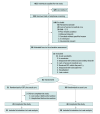Guided Internet-Based Cognitive Behavior Therapy for Women With Bulimia Nervosa: A Randomized Clinical Trial
- PMID: 40762916
- PMCID: PMC12326282
- DOI: 10.1001/jamanetworkopen.2025.25165
Guided Internet-Based Cognitive Behavior Therapy for Women With Bulimia Nervosa: A Randomized Clinical Trial
Abstract
Importance: Despite the rising prevalence of bulimia nervosa and the associated risks of chronicity and severe physical and psychological morbidity, access to effective treatment remains poor. The effectiveness and acceptability of internet-based cognitive behavior therapy (ICBT) for women with bulimia nervosa in clinical settings in East Asia remain unclear.
Objective: To determine the effectiveness and acceptability of a guided ICBT program to treat women with bulimia nervosa in Japan.
Design, setting, and participants: This randomized clinical trial was conducted at 7 university hospitals in Japan between August 2022 and October 2024. This study enrolled female participants aged 13 to 65 years whose symptoms met the Diagnostic and Statistical Manual of Mental Disorders (Fifth Edition) criteria for bulimia nervosa, had a body mass index (BMI) of 17.5 or greater, had internet access, and had no history of practicing CBT-related techniques within the past 2 years.
Interventions: Both the control and intervention groups received usual care. The intervention consisted of ICBT with additional guidance from a therapist. The therapy program was tailored to Japanese culture and grounded in a specific cognitive behavior model, and it was performed over a 12-week period.
Main outcomes and measures: Severity of bulimia nervosa, measured by the weekly combined frequency of episodes involving binge eating and compensatory behaviors, was assessed by a blinded, independent rating team at baseline and at the 12-week intervention end point. Intention-to-treat analyses were conducted using a linear mixed model with effect sizes calculated using Cohen d.
Results: A total of 61 women met the eligibility criteria and were randomized to the intervention group (n = 31) or the control group (n = 30). Participants were predominantly young (mean [SD] age, 27.8 [9.0] years), had normal weight (mean [SD] BMI, 21.1 [3.6]), and had a mean (SD) duration of illness of 9.3 (8.8) years; half (31 [50.8%]) were employed. Intent-to-treat analysis revealed that guided ICBT significantly reduced the weekly combined frequency of episodes involving binge eating and compensatory behaviors (by an adjusted mean difference of 9.84 episodes [95% CI, 2.49-17.18 episodes], P = .01; Cohen d = 0.73 [95% CI, 0.21-1.26]). Sensitivity analyses supported these findings.
Conclusions and relevance: In this randomized clinical trial, the intervention group experienced a significant decrease in bulimia symptoms compared with the control group, supporting the effectiveness and acceptability of the therapist-guided ICBT program. These findings suggest that integration of therapist-guided ICBT in usual care has the potential to improve accessibility to efficacious treatment options for women with bulimia nervosa.
Trial registration: UMIN Clinical Trials Registry Identifier: UMIN00048732.
Conflict of interest statement
Figures


Comment in
- doi: 10.1001/jamanetworkopen.2025.25175
References
-
- American Psychiatric Association . Diagnostic and Statistical Manual of Mental Disorders. 5th ed. American Psychiatric Association; 2013.
-
- Flett GL, Newby J, Hewitt PL, Persaud C. Perfectionistic automatic thoughts, trait perfectionism, and bulimic automatic thoughts in young women. J Ration Emot Cogn Behav Ther. 2011;29(3):192-206. doi: 10.1007/s10942-011-0135-3 - DOI
Publication types
MeSH terms
LinkOut - more resources
Full Text Sources
Miscellaneous

